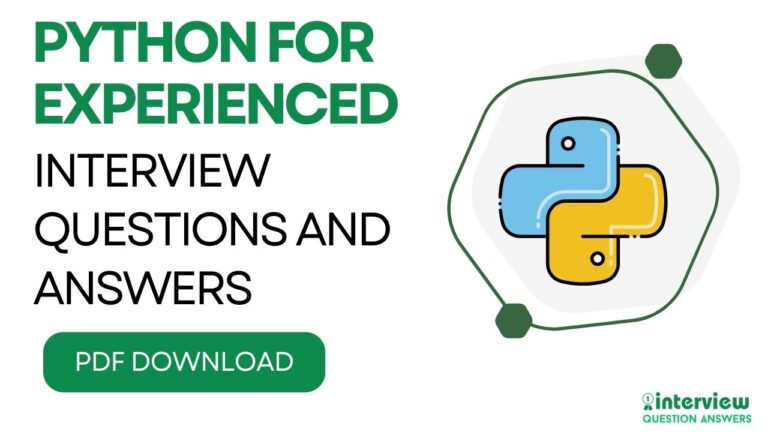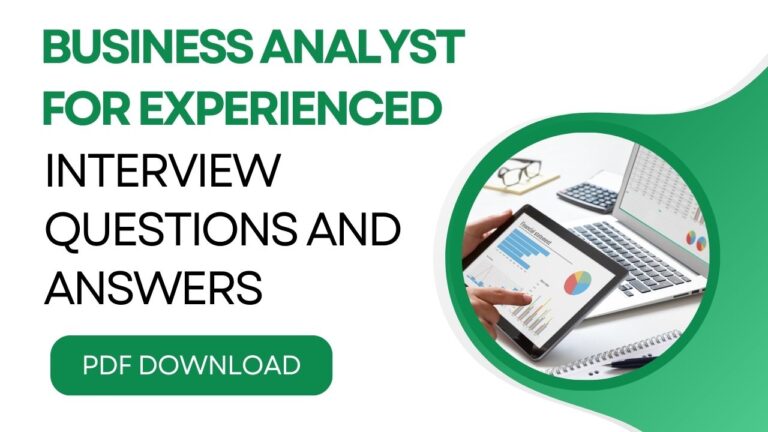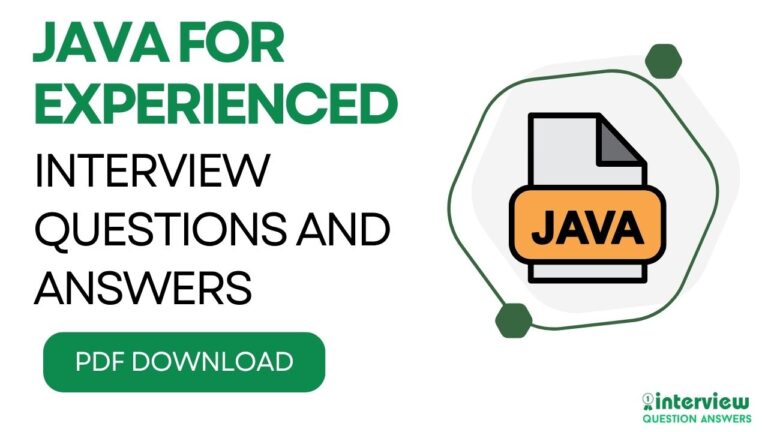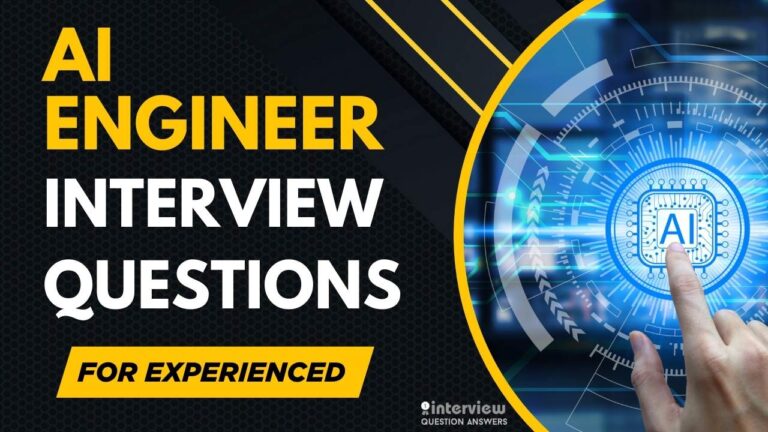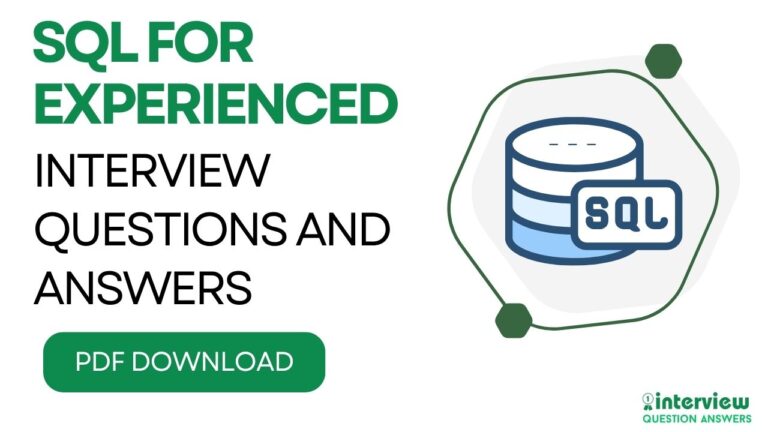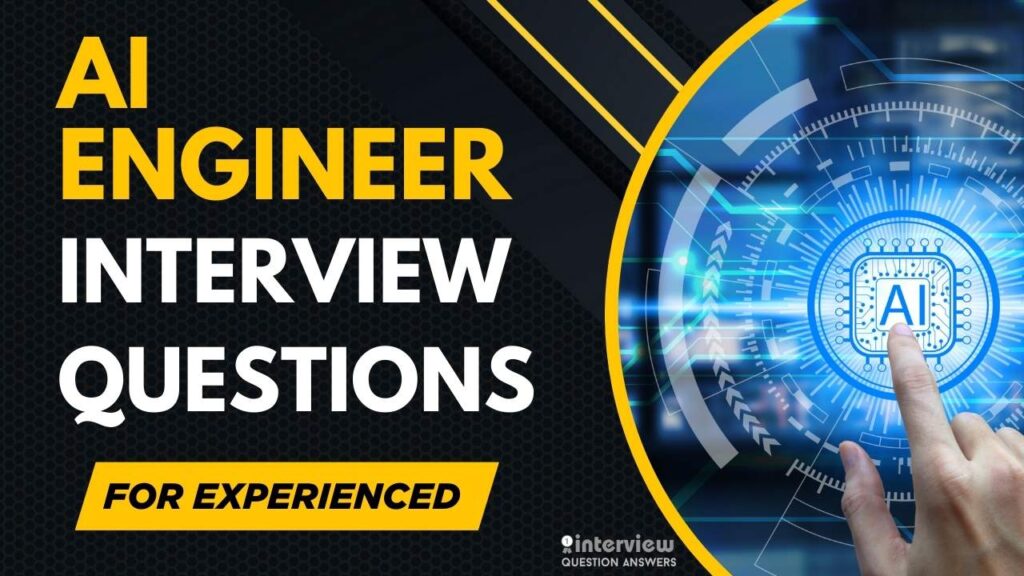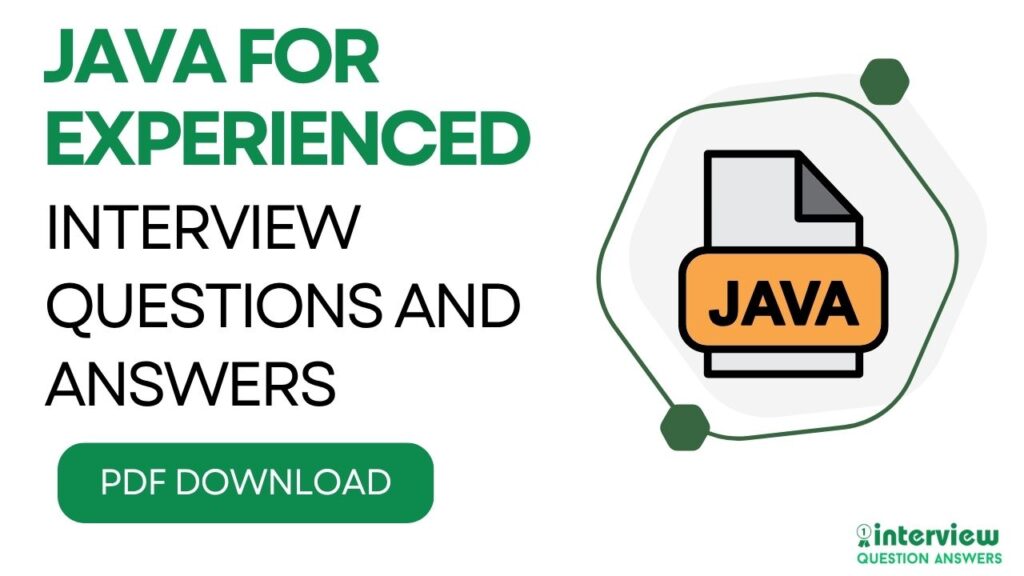Data Analyst Interview Questions for Experienced 2025
Landing a senior data analyst position requires demonstrating advanced analytical expertise and strategic thinking beyond entry-level skills. Data Analyst Interview Questions for Experienced professionals focus on complex scenarios, leadership capabilities, and industry-specific challenges that seasoned analysts encounter.
This comprehensive guide covers Data Analyst Interview Questions for Experienced candidates with 2, 3, 5, 7, and 10 years of experience, addressing advanced statistical modeling, data architecture decisions, and cross-functional collaboration.
These Data Analyst Interview Questions for Experienced professionals will help you showcase your expertise, demonstrate ROI-driven insights, and prove your readiness for senior analytical roles in today’s competitive market.
You can also check another main guide here: Data Analyst Interview Questions PDF
Table of Contents
Business Analyst Interview Questions for 2 Year Experience
Que 1. How do you align business analysis activities with an organization’s strategic objectives?
Answer: Align activities by mapping requirements to strategic goals outlined in the organization’s vision or roadmap. Conduct stakeholder workshops to prioritize initiatives based on business value, use frameworks like Balanced Scorecard, and track KPIs in tools like Power BI. For experienced professionals, integrating enterprise architecture (e.g., TOGAF) ensures long-term alignment while addressing scalability and risk.
Que 2. What is your approach to managing scope creep in a large-scale project?
Answer: Manage scope creep by establishing a clear scope baseline in the BRD, implementing a formal change request process, and using tools like JIRA to track changes. For experienced BAs, conducting impact analyses, presenting trade-offs to stakeholders, and leveraging agile prioritization (e.g., MoSCoW) minimizes disruptions while maintaining stakeholder buy-in.
Que 3. How do you elicit requirements from stakeholders with conflicting priorities?
Answer: Facilitate joint workshops, use prioritization techniques like Weighted Scoring or Kano Model, and document trade-offs in a shared repository like Confluence. For experienced BAs, mediating with data-driven insights (e.g., ROI projections) and maintaining a traceability matrix ensures transparency and consensus.
Que 4. What is the role of a Business Analyst in an Agile environment, and how do you adapt to it?
Answer: In Agile, a BA refines the product backlog, writes detailed user stories, and facilitates ceremonies like sprint planning. Adapt by embracing iterative feedback, collaborating closely with the product owner, and using tools like JIRA. For experienced BAs, ensuring clear acceptance criteria and backlog prioritization drives sprint success.
Que 5. How do you create a comprehensive Business Requirements Document (BRD)?
Answer: A BRD includes business objectives, stakeholder needs, scope, assumptions, constraints, and high-level requirements. For experienced BAs, structure it with sections for functional/non-functional requirements, use case diagrams, and KPIs, validated through stakeholder reviews and maintained in Confluence for traceability.
Que 6. What is the difference between a BRD and a Functional Specification Document (FSD)?
Answer:
| Document Type | Purpose | Content |
|---|---|---|
| BRD | Defines business needs and goals | High-level objectives, scope |
| FSD | Details technical implementation | Functional details, workflows, UI specs |
For experienced BAs, ensuring traceability between BRD and FSD is critical.
Que 7. How do you use a traceability matrix to ensure project quality?
Answer: A traceability matrix links requirements to sources, test cases, and deliverables, ensuring coverage. For experienced BAs, maintain it in JIRA or Excel, update during change requests, and audit regularly to validate implementation and testing.
Example:
| Req ID | Source | Test Case | Status |
|--------|----------------|-----------|----------|
| REQ001 | Stakeholder A | TC001 | Approved |Que 8. What techniques do you use for effective stakeholder analysis?
Answer: Use a power/interest matrix to categorize stakeholders, conduct interviews to understand needs, and prioritize engagement based on influence. For experienced BAs, tools like Miro for visualization and regular stakeholder mapping updates ensure effective collaboration.
Que 9. How do you handle a situation where stakeholders are resistant to change?
Answer: Address resistance using change management frameworks like ADKAR, conducting impact assessments, and demonstrating value through prototypes or pilots. For experienced BAs, tailored communication plans and executive sponsorship drive adoption, tracked via metrics like user engagement.
Que 10. What is your experience with process modeling, and which tools do you prefer?
Answer: Process modeling maps workflows using BPMN or flowcharts to identify inefficiencies. Preferred tools include Visio, Lucidchart, or Bizagi for detailed diagrams. For experienced BAs, integrating process mining tools like Celonis enhances data-driven optimization.
Business Analyst Interview Questions for 3 Year Experience
Que 11. How do you conduct a gap analysis for a business process improvement project?
Answer: Compare “as-is” and “to-be” processes, identifying gaps in efficiency, technology, or resources. For experienced BAs, use data from process mining or KPIs, validate with stakeholders, and propose solutions in a report, leveraging tools like Excel or Power BI for analysis.
Que 12. What is the role of a BA in facilitating user acceptance testing (UAT)?
Answer: A BA defines test scenarios, ensures alignment with requirements, and supports stakeholders during UAT. For experienced BAs, creating detailed test plans in JIRA, tracking defects, and facilitating resolution with developers ensures successful validation.
Que 13. How do you use data analytics to support business analysis?
Answer: Use analytics tools like SQL, Tableau, or Python to analyze trends, validate requirements, or quantify benefits. For experienced BAs, integrating predictive analytics (e.g., regression in Python) and presenting insights via dashboards drives strategic decisions.
Que 14. What is a decision tree, and how do you apply it in business analysis?
Answer: A decision tree maps decisions, conditions, and outcomes to analyze complex choices. For experienced BAs, use it for prioritizing features or assessing risks, created in tools like Draw.io, and validated with stakeholder feedback.
Que 15. How do you manage requirements in a project with multiple vendors?
Answer: Define clear requirements in an SRS, establish SLAs, and use a centralized platform like JIRA for tracking. For experienced BAs, regular vendor syncs, a shared RACI matrix, and performance dashboards ensure alignment and accountability.
Que 16. What is your approach to conducting a cost-benefit analysis for a proposed solution?
Answer: Quantify costs (e.g., development, training) and benefits (e.g., revenue, efficiency) using NPV or ROI calculations. For experienced BAs, perform sensitivity analysis in Excel and present scenarios to stakeholders, ensuring alignment with strategic goals.
Que 17. How do you use prototyping to validate requirements?
Answer: Create interactive prototypes in tools like Figma or Axure to visualize functionality, gather stakeholder feedback, and refine requirements. For experienced BAs, iterative prototyping with usability testing ensures accurate implementation.
Que 18. What is the role of a BA in risk management for a project?
Answer: Identify risks through SWOT or PESTLE analysis, assess impact/likelihood, and document in a risk register. For experienced BAs, use Monte Carlo simulations in tools like @Risk for quantitative analysis and monitor mitigation plans in JIRA.
Que 19. How do you ensure data quality in a project involving multiple data sources?
Answer: Define data quality metrics (e.g., accuracy, completeness), validate sources with SQL queries, and implement cleansing rules. For experienced BAs, use ETL tools like Talend and collaborate with data engineers to ensure consistency.
Que 20. What is your experience with enterprise resource planning (ERP) implementations?
Answer: Support ERP implementations by defining requirements, mapping processes, and facilitating data migration. For experienced BAs, expertise in tools like SAP or Oracle NetSuite, along with stakeholder training and change management, ensures successful rollouts.
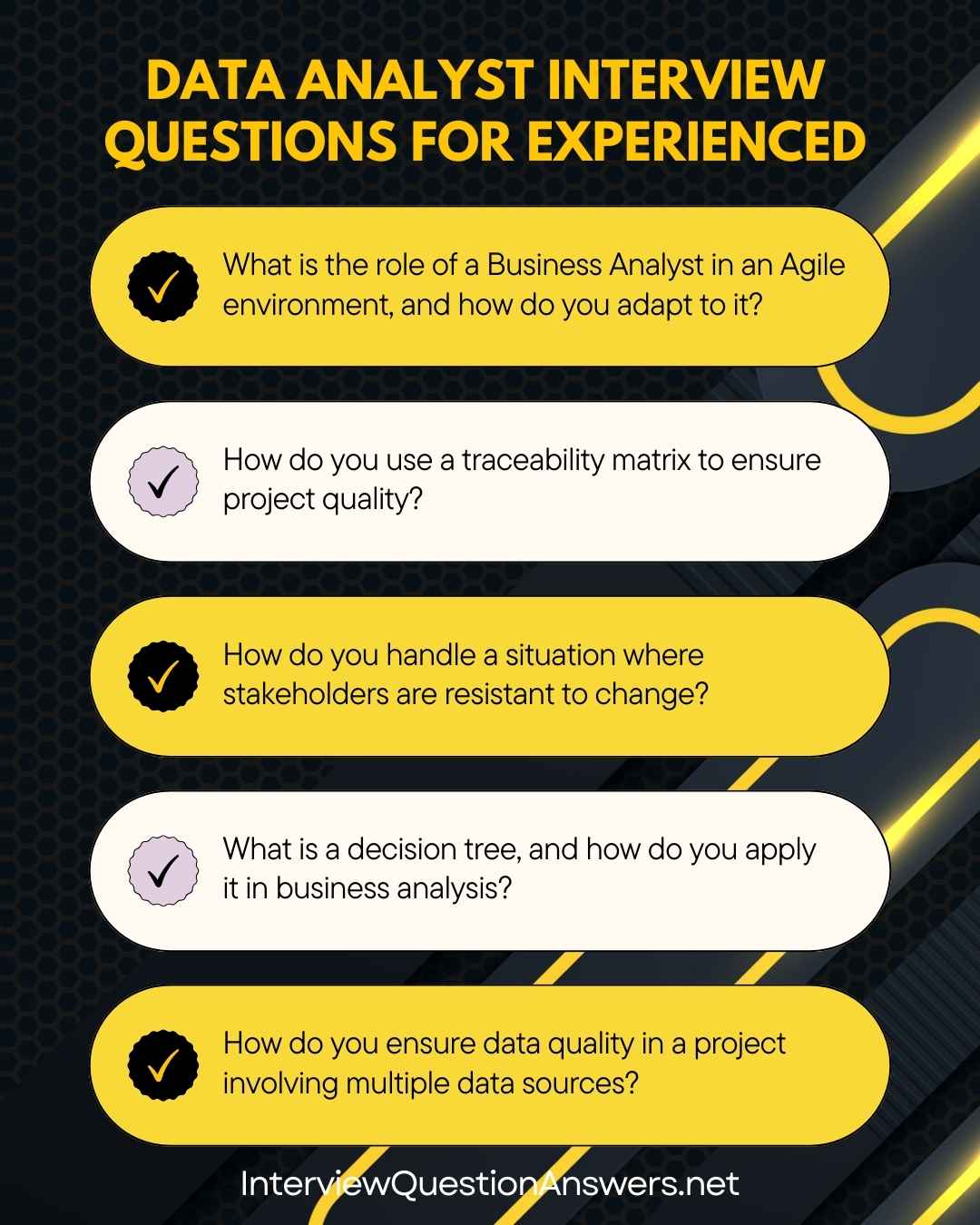
Also Check: Business Analyst Interview Questions for Freshers
Business Analyst Interview Questions for 5 Year Experience
Que 21. How do you use a RACI matrix to manage project responsibilities?
Answer: A RACI matrix (Responsible, Accountable, Consulted, Informed) clarifies roles for tasks. For experienced BAs, create it in Excel or Confluence, review with stakeholders, and update during project changes to avoid overlaps.
Example:
| Task | PM | BA | Developer |
|--------------|------|------|-----------|
| Requirements | A | R | C |Que 22. What is your approach to backlog refinement in Agile projects?
Answer: Refine the backlog by prioritizing user stories, adding detailed acceptance criteria, and estimating effort with the team. For experienced BAs, use tools like JIRA, conduct grooming sessions, and align with sprint goals to ensure deliverable clarity.
Que 23. How do you incorporate regulatory compliance into business analysis?
Answer: Map regulations (e.g., GDPR, HIPAA) to requirements, embed controls in the SRS, and validate with audits. For experienced BAs, collaborate with legal teams and use compliance tools like OneTrust to ensure adherence and traceability.
Que 24. What is the role of a BA in a DevOps-driven project?
Answer: A BA defines requirements for CI/CD pipelines, automates processes, and ensures business alignment. For experienced BAs, collaborate on tool selection (e.g., Jenkins), monitor metrics like deployment frequency, and facilitate cultural shifts using change management.
Que 25. How do you use process mining to enhance business analysis?
Answer: Process mining analyzes event logs to uncover inefficiencies, using tools like Celonis or ProcessGold. For experienced BAs, map processes, identify deviations, and propose optimizations, validated with KPIs like cycle time reduction.
Que 26. What is your experience with integrating APIs into business processes?
Answer: Document API requirements, test endpoints with Postman, and map data flows to business needs. For experienced BAs, ensure security (e.g., OAuth) and monitor performance with tools like New Relic, optimizing workflows like payment processing.
Que 27. How do you conduct a post-implementation review for a project?
Answer: Gather stakeholder feedback, compare outcomes to objectives, and analyze KPIs using tools like Power BI. For experienced BAs, document lessons learned in Confluence, recommend improvements, and track action items in JIRA for continuous improvement.
Que 28. What is your approach to managing technical debt in a project?
Answer: Identify technical debt during requirements reviews, prioritize refactoring with developers, and track in JIRA. For experienced BAs, balance debt resolution with new features, using impact analysis to justify investments to stakeholders.
Que 29. How do you use predictive analytics in business analysis?
Answer: Use tools like Python (scikit-learn) or Power BI for predictive models to forecast trends or risks. For experienced BAs, validate models with stakeholders, integrate into decision-making, and monitor accuracy with metrics like RMSE.
Example:
from sklearn.linear_model import LinearRegression
model = LinearRegression()
model.fit(X_train, y_train)
predictions = model.predict(X_test)Que 30. What strategies do you use to drive organizational change through business analysis?
Answer: Apply frameworks like Kotter’s 8-step model, conduct impact assessments, and develop training plans. For experienced BAs, use stakeholder engagement strategies, track adoption metrics in Power BI, and align changes with strategic goals to ensure sustainable transformation.
Business Analyst Interview Questions for 7 Year Experience
Que 31. How do you integrate enterprise architecture frameworks like TOGAF into business analysis to support digital transformation?
Answer: Integrate TOGAF by aligning business analysis with the Architecture Development Method (ADM), starting with defining the business vision and mapping capabilities to strategic goals. Use artifacts like business capability maps and value stream diagrams to identify gaps and prioritize digital initiatives. For experienced BAs, leverage tools like ArchiMate for modeling and conduct iterative stakeholder reviews to ensure alignment with enterprise-wide transformation objectives, addressing challenges like legacy system integration through phased roadmaps.
Que 32. What is your approach to managing stakeholder expectations in a project with competing business units and limited resources?
Answer: Manage expectations by conducting a stakeholder analysis with a power/interest matrix, prioritizing high-influence stakeholders, and using decision-making frameworks like Weighted Shortest Job First (WSJF). For experienced BAs, facilitate cross-unit workshops, present data-driven trade-offs (e.g., ROI projections in Excel), and maintain transparency via dashboards in Power BI. Mitigate conflicts by establishing a governance council and tracking decisions in Confluence.
- Conduct stakeholder mapping.
- Use WSJF for prioritization.
- Implement governance for alignment.
Que 33. How do you leverage process mining to optimize complex, cross-functional business processes?
Answer: Use process mining tools like Celonis or UiPath Process Mining to analyze event logs, visualize workflows, and identify inefficiencies like bottlenecks or deviations. For experienced BAs, map “as-is” processes with BPMN, propose “to-be” optimizations, and validate with KPIs like cycle time reduction. Integrate findings with ERP systems (e.g., SAP) and ensure stakeholder buy-in through data-driven presentations, addressing scalability challenges.
Que 34. What is your experience with implementing robotic process automation (RPA) in business processes?
Answer: Support RPA by identifying repetitive tasks, defining automation requirements, and collaborating with developers on tools like UiPath or Automation Anywhere. For experienced BAs, conduct cost-benefit analyses, pilot automations, and measure metrics like error reduction. Challenges like process standardization are addressed by mapping workflows and ensuring integration with existing systems.
Example:
**RPA Use Case: Invoice Processing**
- Task: Automate data entry.
- Tool: UiPath.
- Metric: 80% time reduction.Que 35. How do you use predictive analytics to enhance business analysis outcomes?
Answer: Apply predictive analytics using tools like Python’s scikit-learn or Power BI to forecast trends, risks, or customer behavior. For experienced BAs, define data requirements, validate models with stakeholders, and integrate predictions into decision-making processes. Monitor model accuracy with metrics like R-squared and address biases through iterative retraining.
Que 36. What is your approach to conducting a comprehensive risk analysis for a global project?
Answer: Conduct risk analysis using frameworks like COSO, identifying risks via PESTLE and SWOT analyses, and quantifying with Monte Carlo simulations in tools like @Risk. For experienced BAs, prioritize risks by impact/likelihood, develop mitigation plans, and monitor via dashboards in Power BI. Ensure global alignment by addressing cultural and regulatory risks.
Que 37. How do you ensure compliance with data privacy regulations like GDPR in business analysis?
Answer: Ensure GDPR compliance by mapping data flows, embedding privacy controls in requirements, and conducting DPIAs (Data Protection Impact Assessments). For experienced BAs, collaborate with legal teams, use tools like OneTrust for compliance tracking, and train stakeholders on data handling. Maintain traceability to regulations in JIRA to avoid penalties.
Que 38. What strategies do you use to manage technical debt in a long-term project?
Answer: Identify technical debt during requirements reviews, prioritize refactoring based on impact, and track in JIRA. For experienced BAs, balance debt resolution with new features through stakeholder negotiations, using impact analyses to justify investments. Monitor debt reduction with metrics like code quality scores in SonarQube.
Que 39. How do you incorporate sustainability goals into business analysis for system implementations?
Answer: Incorporate sustainability by defining green KPIs (e.g., energy consumption reduction) in requirements, selecting eco-friendly vendors, and aligning with ESG frameworks. For experienced BAs, conduct lifecycle assessments, integrate sustainability metrics into dashboards, and ensure stakeholder alignment through strategic workshops.
Que 40. What is your experience with facilitating DevOps adoption in an organization?
Answer: Facilitate DevOps by defining requirements for CI/CD pipelines, selecting tools like Jenkins, and aligning with business agility goals. For experienced BAs, monitor metrics like deployment frequency, drive cultural change through training, and integrate with agile processes to ensure continuous delivery.
- Define automation requirements.
- Track DevOps KPIs.
- Facilitate cross-team training.
Business Analyst Interview Questions for 10 Year Experience
Que 41. How do you use value stream mapping to drive operational excellence?
Answer: Use value stream mapping to visualize end-to-end processes, calculate lead and value-added times, and identify waste (e.g., delays). For experienced BAs, propose optimizations with kaizen bursts, implement in tools like LeanKit, and measure improvements with KPIs like throughput, ensuring stakeholder validation.
Que 42. What is your approach to leading a business case for a multimillion-dollar digital initiative?
Answer: Develop a business case by conducting stakeholder needs analysis, performing cost-benefit analysis with NPV/IRR, and modeling risks with Monte Carlo simulations. For experienced BAs, present multiple scenarios in PowerPoint, secure C-level approval, and track benefits realization with dashboards in Tableau.
Que 43. How do you integrate APIs into business processes to enhance efficiency?
Answer: Document API requirements, test endpoints with Postman, and map data flows to business needs. For experienced BAs, ensure security with OAuth, monitor performance with New Relic, and optimize workflows like real-time inventory updates, addressing integration challenges with middleware.
Que 44. What is your experience with enterprise data lakes in business analysis?
Answer: Leverage data lakes by defining data requirements, integrating sources via ETL tools like Apache NiFi, and querying with Snowflake. For experienced BAs, design governance models, create analytics dashboards in Tableau, and address data consistency with metadata management.
Que 45. How do you use decision tables to manage complex business rules?
Answer: Create decision tables to outline conditions, actions, and outcomes for complex rules, ensuring clarity for developers. For experienced BAs, use tools like Excel or Visio, validate with stakeholders, and integrate into SRS for implementation.
Example:
| Condition: Age | Condition: Member | Action: Discount |
|----------------|------------------|------------------|
| >= 18 | Yes | 20% |
| < 18 | No | 0% |Que 46. What is your approach to managing organizational change in a global ERP implementation?
Answer: Use frameworks like Prosci ADKAR, conduct impact assessments, and develop global training programs. For experienced BAs, align change with strategic goals, track adoption metrics in Power BI, and address cultural differences with localized strategies, ensuring sustained transformation.
Que 47. How do you use process simulation to validate proposed business processes?
Answer: Use simulation tools like Arena or AnyLogic to model proposed processes, test scenarios, and analyze outcomes like throughput. For experienced BAs, validate with stakeholders, integrate real data, and optimize based on simulation results to ensure feasibility.
Que 48. What is your experience with integrating machine learning models into business analysis?
Answer: Define requirements for ML models, collaborate with data scientists, and validate outputs for business use cases like demand forecasting. For experienced BAs, use tools like Python’s scikit-learn, monitor model performance with metrics like precision, and ensure ethical use through governance.
Que 49. How do you ensure traceability in a project with evolving requirements?
Answer: Maintain a traceability matrix in JIRA or Excel, linking requirements to sources, test cases, and deliverables. For experienced BAs, automate traceability with tools like IBM Rational DOORS, audit regularly, and update during change requests to ensure compliance and coverage.
Que 50. What strategies do you use to drive data-driven culture in an organization?
Answer: Promote a data-driven culture by implementing analytics platforms (e.g., Tableau), training stakeholders on data literacy, and embedding KPIs in decision-making. For experienced BAs, establish data governance, use predictive models for strategic insights, and monitor adoption with metrics like dashboard usage.
Conclusion
We have already shared the essential questions for Data Analyst Interview Questions for Experienced professionals. This comprehensive Data Analyst Guide includes interview questions for experienced candidates with 2, 3, 5, 7, and 10 years of experience, covering advanced analytical concepts and leadership scenarios that employers evaluate. The data analytics industry is rapidly evolving with AI integration, cloud platforms, and advanced machine learning becoming standard requirements for senior roles.
These Data Analyst Interview Questions for Experienced professionals provide the strategic foundation needed to advance your career, covering complex data modeling to business intelligence leadership. With proper preparation using these Data Analyst Interview Questions for Experienced and understanding current industry demands, you’ll be well-positioned to secure senior data analytics positions.
Related Interview Guides:


